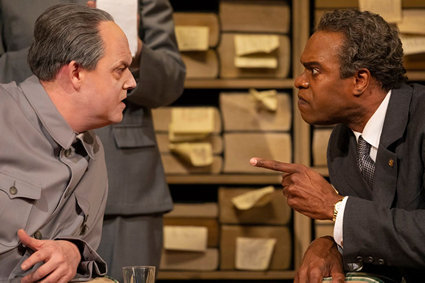| Opera Reviews | 24 April 2024 |
History recreated from the archivesby Catriona Graham |
|
| Adams: Nixon in China
Scottish Opera February 2020 |
|

Mark Le Brocq (Mao Tse-tung), Eric Greene (Richard Nixon)
|
|
|
Gosh! I had forgotten so much. Many operas are based on historical events and characters, but when the event happens within one’s lifetime, there is a mental cross-checking of what is happening on stage with what is remembered. So director John Fulljames and the design team set Scottish Opera’s co-production of Nixon in China with The Royal Danish Theatre and Teatro Madrid in an archive, where black-dressed, white-gloved archivists go through boxes of photos, papers and other artefacts. The photos are projected and come to life; eight screens circle on-stage, showing Air Force One Boeing 707 on its final approaches to Peking airport. The gangway, down which Nixon and his wife Pat, emerges from the archive stacking. This is a fully mixed-media production, with visuals flowing on the surfaces – sliding stacks, revolving room-sized boxes – behind the protagonists, sometimes portraying the original of the action taking place, sometimes filling in the backstory. Julia Sporsén is uncannily like Pat Nixon, in her blonde hair-do and red coat. Eric Greene provides the Republican Party its first black president – but this is no virtue-signalling, colour-blind casting. He, too, looks convincingly like Nixon and he gives a powerful performance; the off-the cuff remarks which alarm and exasperate his National Security Adviser Kissinger (David Stout), the surprisingly touching and intimate third act conversation with his wife, recounting the occasion in the Pacific during the Second World War when he expected to be killed by Japanese bombs. Mark Le Brocq conveys the slight detachment of the ailing Mao, no longer really bothered by state-craft, but wanting to discuss philosophy. Chou En-lai, in a short passage near the end of the opera, expresses his own doubts about the number of people he has killed. Nicholas Lester is measured but robust in his portrayal of the Chinese premier. The second act belongs to the two wives, as Pat Nixon is taken on a tour of factories, farms and schools – the visit to the pigs enhanced by convincing noises from the chorus. Then there is the revolutionary ballet, devised by Madame Mao, which depicts a typical tale of landlord exploitation of the peasants, whereupon the exploited is rescued by communists and takes up arms against the landlord; the dancers are excellent, in their sky-blue uniforms with red neckerchiefs. Pat’s horror at the exploitation of the peasant girl is palpable. Hye-Youn Lee’s Madame Mao is dismissive of Pat’s concern with the personal. David Stout is a twinkling, jovial Kissinger, trying to do the diplomatic thing; the official banquet and its toasts, to shouts of ‘Gam bei’, degenerates into a bit of a rammy. The three official secretaries to Mao – Louise Callinan, Sioned Gwen Davies and Emma Carrington – take notes of and comment on the action, as well as participating. John Adams’ music is sometimes spiky, sometimes lyrical, particularly in the third act where the two couples reminisce about their early, courting days. With Joana Carneiro conducting the orchestra, it moves along, well-paced, with space for things to happen, for connections to be made and missed.
|
|
| Text © Catriona Graham Photo © James Glossop |
|







